Portuguese fruits are one of the things the people in this country take their pride in. In each season, there are so many types of fresh fruits you can choose from, and they are always of the best quality. Some can also be a good component to your delicious and savory Portuguese dishes.
This list below consists of the most popular fruits at different times of the year in Portugal. You may already be familiar with some of them. However, because of the geographic features of Portugal give these fruits their unique fruity flavor. Let’s start!
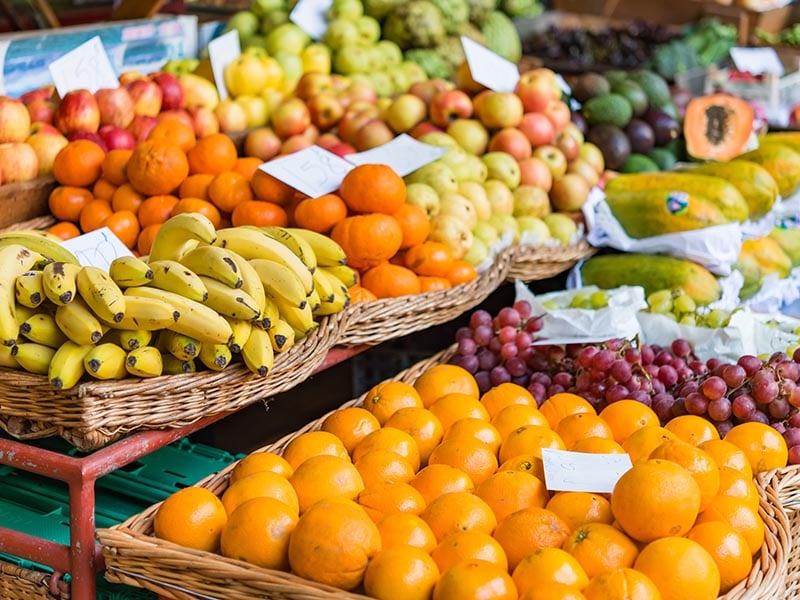
2 Fruits You Can Buy At Any Time When Visiting Portugal
What if you decide to spontaneously travel to Portugal without any plan? For the fruit fanatics, you don’t have to worry about finding available fruits here in this country. You can always get plenty of them when visiting Portugal. Let’s read about them!
1. Maçã (Apples)
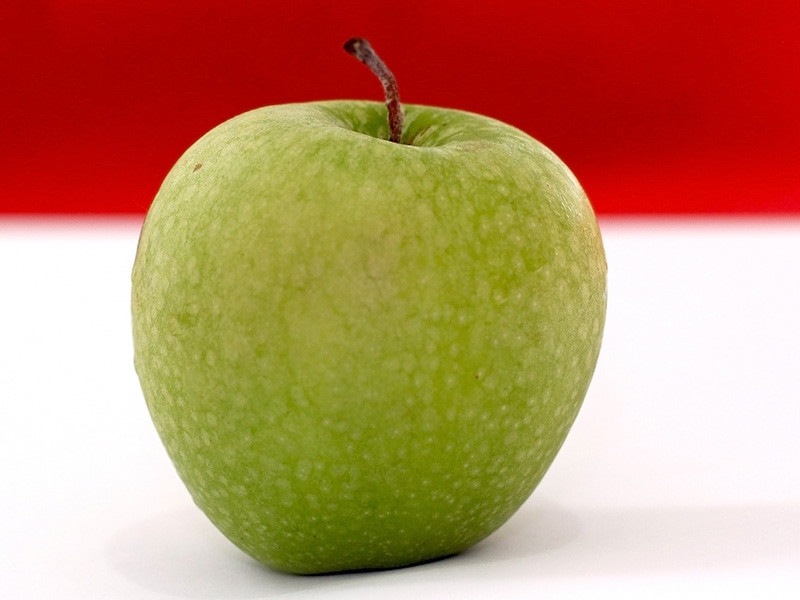
The people here in Portugal are blessed with the country’s famous apple type, Maçã de Alcobaça, or apple of Alcobaça. These apples are deliciously fragrant and sweet, with a hint of pineapple in the taste. You can either eat or juice those terrifically juicy apples.
Besides Maçã de Alcobaça, you will also come across other types of apples like Maçã Bravo de Esmolfe, which are green apples with a powerful aroma. Another type is Maçã Riscadinha de Palmela, apples with a beautiful pale-colored skin.
More than just the fruit itself, locals use apples in many traditional Portuguese dishes. One of Portugal’s most famous apple desserts is baked apples (Maçã Assada) with Port wine and cinnamon. It is an easy-to-make dessert that many restaurants in Portugal feature.
Season: Apples are available all year round.
Healthy nutrients: Apples are low in sodium and cholesterol. It also provides you with vitamin C and fiber.
How to eat: Wash them thoroughly and bite through the fruit. You can use apples to make pies and other dessert dishes. Many Portuguese families know a trick or two with these delicacies.
2. Ananás (Pineapples)

During the Brazilian colonial era, the Portuguese discovered the fruit and transported them to the Azores islands, an autonomous region of Portugal, where they started growing it. Ever since, these pineapples have become Portugal’s specialty.
People all across Portugal grow and consume pineapples in greenhouses all year round. In São Miguel island alone, there are approximately 6000 greenhouses that grow pineapples. Each crop usually takes around 2 years to yield the juiciest fruits.
These pineapples are famous for their unique appearance with little spikes that form a small crown for the fruit. The taste is also something worth noticing as it is packed with unforgettable sweetness and fragrance.
Season: You can get pineapples any time of the year in Portugal.
Healthy nutrients: Pineapples are rich in manganese, vitamin C, and antioxidants.
How to eat: Remove the stem and background, cut the outer spiny layer, and cut the fruit into small pieces. Eat the fruit on its own or make a fruit salad with it.
Try These 9 Seasonal Fruits In Portugal For A Great Experience
Not all fruits are available for you to try in this country at all times. Having said that, if you happen to travel in the peak season of any of these fruits, it will be totally worth it. These Portuguese fruits are, in my opinion, the real definition of the words “plump” and “juicy”.
3. Laranja (Oranges)
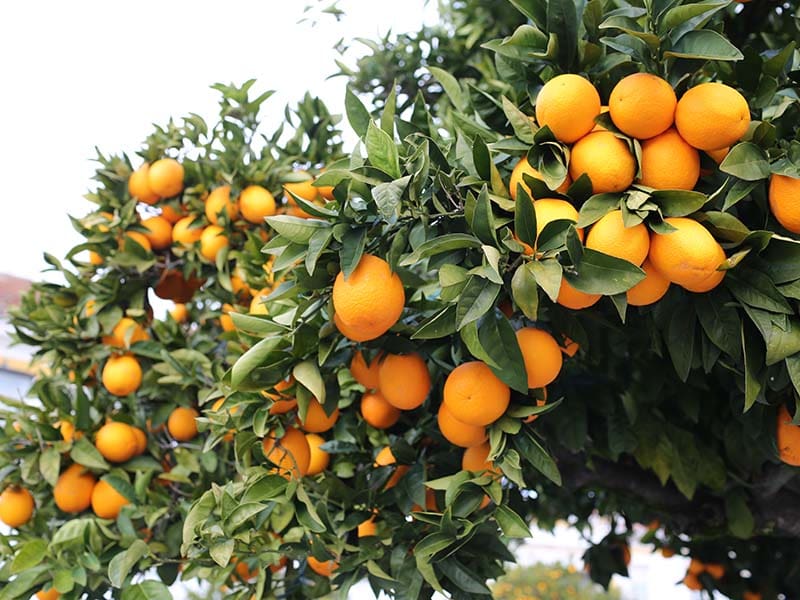
People here in Portugal produce and consume oranges throughout the year. It is actually the second-most produced fruit in Portugal after apples. However, there are varieties of oranges in Portugal that are available mid-season and late-season.
Starting from mid-autumn, you can find Dalmau and Newhall oranges present in Portugal. These oranges are very juicy and light in color. The Dalmau oranges are sweet and subtle in taste. A fun fact about Newhall oranges is that they also go by Navel oranges.
The oranges in Portugal were once very expensive and a symbol of extravagance. The renowned French playwright Molière mentioned such status in his famous play The Miser. This is easy to understand since Portuguese oranges are irresistibly sweet and juicy.
You can find various orange fruits in Portugal when traveling here. The best tip to get around these orange trees and choose the best ones for you is to ask the locals.
Season: Oranges are harvested in many seasons. But you can find the most delicious Newhall oranges from late autumn (November).
Healthy benefits: In oranges, you can find nutrients like vitamin C, folate, and calcium.
How to eat: Cut the oranges in wedges and enjoy them fresh. This fruit is also great for making juice.
This is what it feels like walking through an orange farm in Portugal.
4. Kiwi (Kiwi)
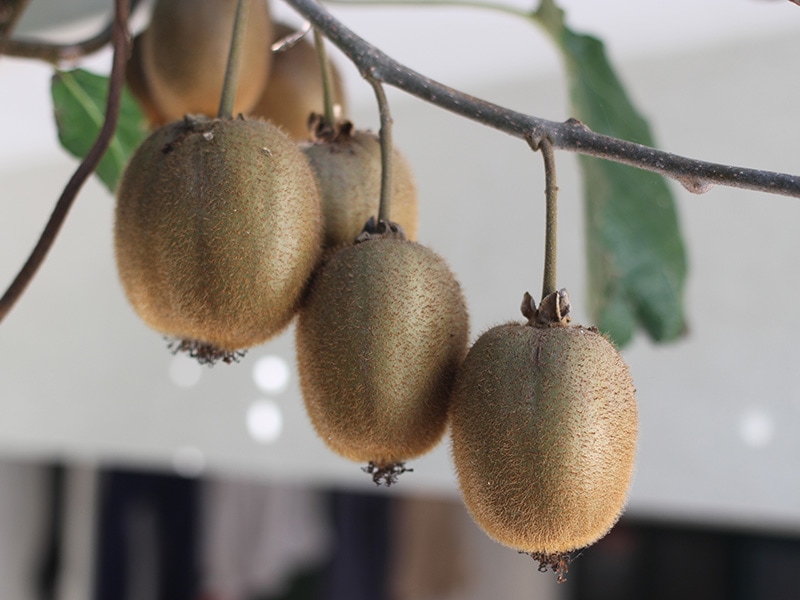
Kiwi fruits in Portugal are actually sweeter compared to those grown in other countries, thanks to the Iberian country’s climate and soil conditions. Plus, people here in Portugal pick kiwis later in the harvest season, making them more ripe and sweet.
It is also amazing how quickly the Portuguese adopted this fruit and made it the most widely produced and consumed fruit in the country. Among European countries, Portugal ranks 4th in terms of kiwi production.
Hayward is the most popular type of kiwi in Portugal, making its debut in the 1980s. Since then, locals have made various daily meals with kiwi. It’s because this fruit is neither too soft nor too firm, and the taste displays the right acidity with a bit of sweetness.
Season: Kiwi fruits are available from October to May.
Healthy nutrients: Kiwi is a good source of vitamin C and fiber.
How to eat: Slice the fruit and scoop out the green flesh to enjoy. You can eat kiwi on its own or put it in fruit salad and yogurt.
5. Figo (Figs)

Portugal is the ideal land to grow figs due to its hot and dry climate. Specifically, the southernmost region of the Algarve is where most of the country’s fig fruits come from.
This fruit reminds the locals in Portuguese of the holidays when they would spend time in their grandparents’ backyard all day long. There they would climb onto the trees full of fruits and pick the sweetest and nicest-looking figs they find.
The production of figs can be a risky business since the trees only bear fruit for around 5 months, and people can only consume figs within 3 days after harvesting. This makes figs a pricey type of fruit. Nevertheless, people here still enjoy munching on this delightful fruit.
Season: People usually harvest figs from May to October.
Healthy nutrients: Figs are a good source of calcium and potassium.
How to eat: You can eat this fruit raw by removing the stem and biting right into the skin and flesh. Boiling, broiling, and grilling are also options you can choose to enjoy fig fruits.
6. Melão (Melons)
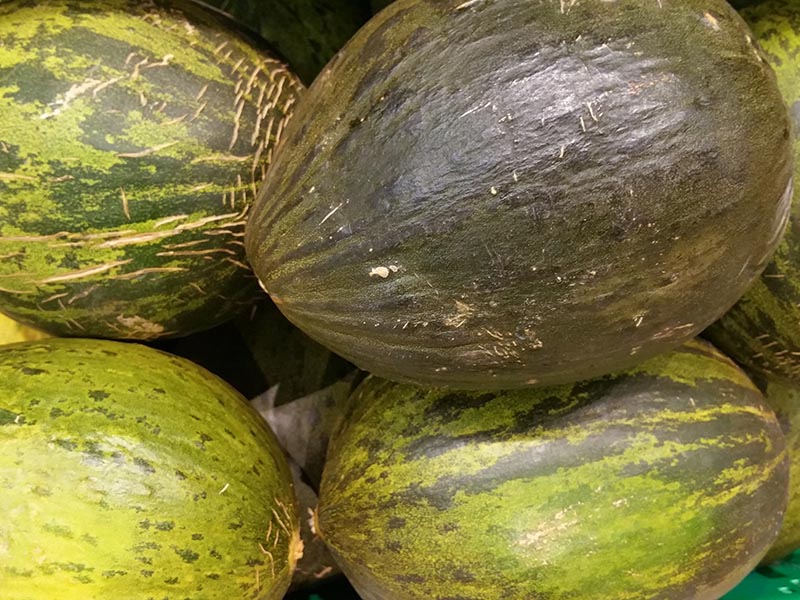
One of Portugal’s summer delights is eating melons. But choosing melons here in Portugal is like gambling. You can win a jackpot with ripe and sweet melons, or you can end up with a bland and tasteless one.
However, you can still find the sweetest melons in the Alentejo region of Portugal. The place is full of sunlight, which is the perfect condition to grow juicy and sweet melons. The most common way to enjoy this fruit is to bite straight into them or pair them with some cured ham for a light lunch.
Season: You can find the sweetest melons in Portugal from July to October.
Healthy nutrients: Melons are a great source of vitamin C, vitamin B6, and magnesium.
How to eat: Cut the fruit in half and remove the seeds. Cut into slices and enjoy raw. You can also wrap the cured ham around the melons and eat it as an appetizer.
What does it feel like to eat a Portuguese melon? Find out here.
7. Melancia (Watermelons)
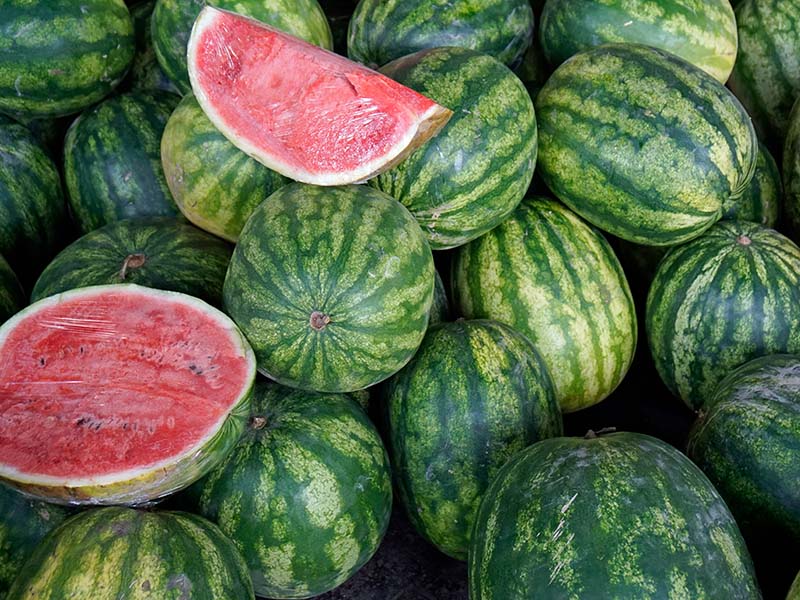
In Portugal, watermelons come mainly from the Alentejo in southern Portugal and Ribatejo in the central region. The juicy, low-calorie fruit is a perfect summer delicacy. Portuguese watermelons also contain more health-beneficial antioxidants and boast a more vibrant red hue.
This sweet summer crop is easy to find in supermarkets, local fairs, and weekend markets. In the summer, when you go on a vacation in Portugal, be sure to buy some and go for a taste. Those thirst-quenching watermelons taste exceptionally great in the hot heat of the country.
Season: Watermelons are available throughout spring and summer in Portugal. But the best watermelons are at the end of summer.
Healthy nutrients: You will get an abundance of vitamin A and certain amino acids in slices of watermelons.
How to eat: Slice the watermelon or cut them into cubes to enjoy. You can also make some juice out of it.
8. Pêssego (Peaches)
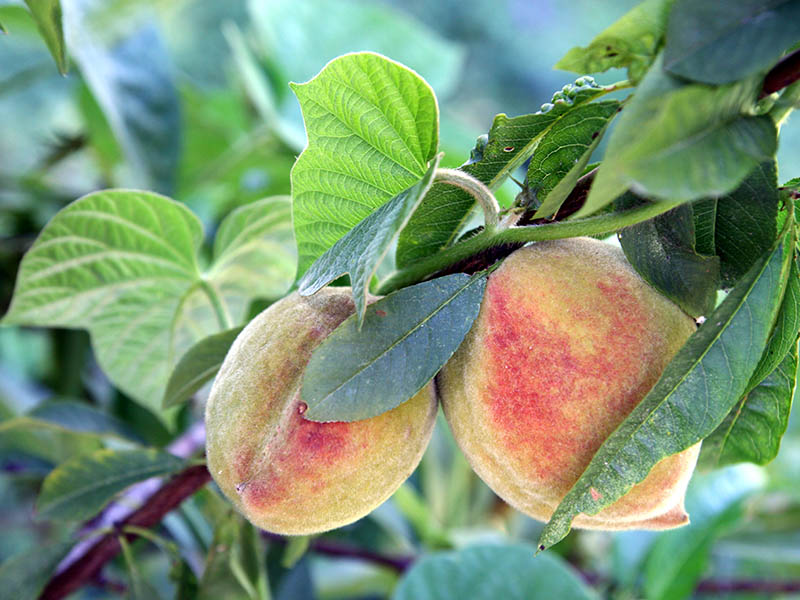
Peaches here in Portugal are famous for their juiciness and plump-looking appearance. Originally from China, the fruit spread rapidly throughout the Mediterranean before the Portuguese introduced them to the Americas.
The most famous kind of peaches in Portugal has to be Cova da Beira with some varieties of Dixired, Red Top, Carnival, and Halloween. Each of these varieties has its different colors due to the harvest time and maturing process.
Cova da Beira peaches are usually juicy and very aromatic. They are mostly famous for the vibrant color of the fresh, as well as the sweet taste and the fruity flavors. When you take a bite, the fruit will welcome your palate with its sweet and refreshing nectar.
Season: May through August.
Healthy nutrients: You can find loads of magnesium, zinc, and copper in peaches.
How to eat: You can eat fresh peaches by washing them and cutting the skin off. You can also poach them in liquor for a nice dessert treat.
9. Pera (Pears)

Portugal is known for its variety of pears called “Pera Rocha”. In 1836, a man called Pedro António Rocha discovered a strange pear tree on his property. From the fruit of this tree came the seeds of Rocha pears.
Rocha pears are native to Oeste, a region in northern Lisbon. With the decline of pear production in Europe in the 1990s, Rocha pears quickly dominated the market. It is also very popular, being the fourth most consumed fruit with 6.3 kilos for each Portuguese (by 2018 estimates).
When unripe, the fruit has a certain crispness. On the other hand, ripe pears have yellow skin, accompanied by a sweet taste and juicy texture. Still, compared to other types of pears, the Rocha variety tends to be drier as well as more subtle in flavor. And much more expensive.
Season: Rocha pears begin ripening in early autumn.
Healthy nutrients: Pears are rich in vitamins and minerals like copper and potassium. The skin also provides antioxidants.
How to eat: Rocha pears taste best when they’re fresh. But you can also blend them into a smoothie to make a beautiful Portuguese drink or cook and bake them as pastry.
10. Cherries
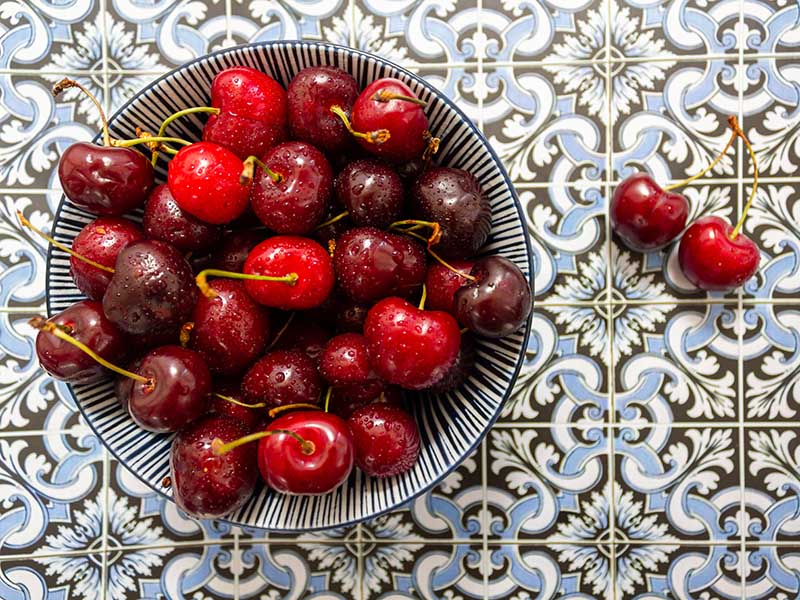
Cherries are what mark the arrival of spring in Portugal. Some of the best cherries that people can get in Portugal are from Leiria, a district in central Portugal. This type of cherry is called Ginja de Óbidos e Alcobaça (sour cherries from Óbidos and Alcobaça).
This type of cherry is tasty and has firm flesh. It’s characterized by a unique balance of sweet and sour flavors. People in Portugal also love Ginja de Óbidos e Alcobaça for its beautiful and vibrant shade of red.
You can also find other types of cherry in Portugal: Cereja da Cova da Beira or Cereja de São Julião-Portalegre. Use these cherries to make numerous desserts and other dishes. There are other cherry-based products like jam, gin, chocolate, etc.
Season: May and June are the peak months to harvest cherries in Portugal.
Healthy nutrients: You’ll get a lot of minerals, as well as vitamin A and vitamin C in cherries.
How to eat: Pick the stem and bite into the fruit with the skin on. Don’t forget to discard the small pit inside. Besides eating raw cherries, you can also use them for salads or desserts.
Check out how to make the famous cherry liquor Ginja from Portugal here.
11. Caqui (Persimmons)
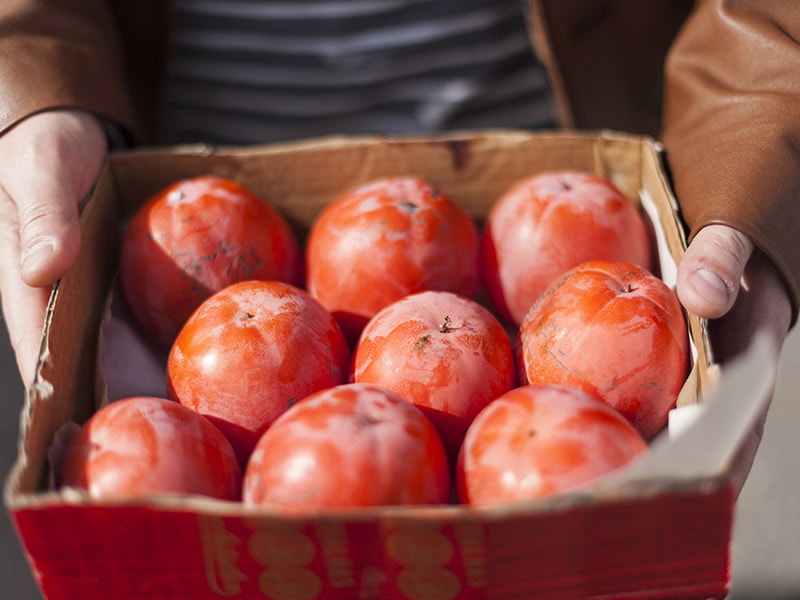
Persimmons are also another long-awaited fruit for the people in Portugal every approaching autumn. It is originally from China, and people mainly produce it in the Algarve region of Portugal as the fruit adapts well to the fairly dry climate here.
This is a type of fruit that takes very little time to ripen. Interestingly, you may make tasty dishes with persimmons to enjoy the fruits in whatever way you want. To look for the ripe ones, touch and feel the softest ones. That’s how you know they are ready.
If you are unfortunate and have picked and tried the unripe persimmons, it can be a very unpleasant experience. Unripe persimmons contain a high amount of tannins, which can leave a waxy and sticky feeling on your teeth and tongue.
Season: People start to harvest persimmons in Portugal around October.
Healthy nutrients: Persimmons are extremely rich in manganese, vitamin A, and vitamin C.
How to eat: Wash the fruit beforehand, cut it in half and enjoy it just like that. Don’t worry; the peel is edible and completely safe.
Are You Ready For Your Fruity Adventure In Portugal Now?
Hopefully, this brief introduction to these Portuguese fruits has prepared you with a solid stepping stone into the colorful world of the fruits in this country. These fruits are quite unique in terms of taste. If possible, you should go to Portugal to explore the fullest savor they can offer.
Whenever you’re traveling to Portugal, feel free to refer to this article for a suggestion or two about what fruit to get in the country. If you have had the opportunity to dig into any of these exotic fruits, tell me what you think about their taste in the comment sections.
Enjoy your fruits, and thank you!
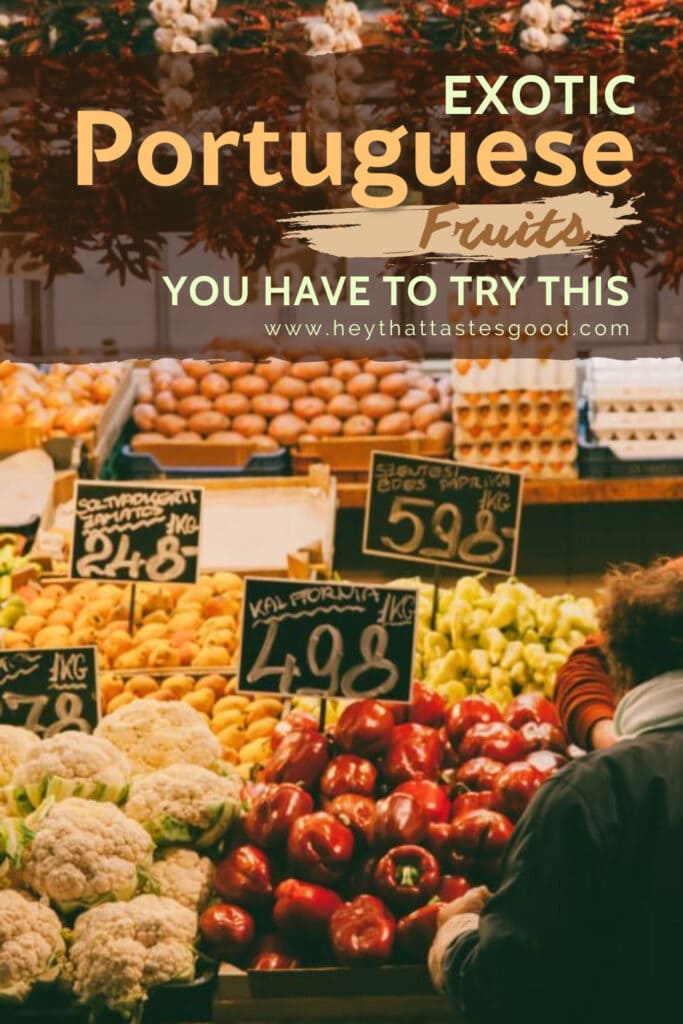


Linda Dean
Expertise
Culinary Arts, Food Journalism, Global Cuisine, Exploration, Recipe Development, Cultural Food Studies, Culinary Travel and Storytelling
Education
Culinary Institute of America, Hyde Park, NY
Program: Associate in Culinary Arts
Focus: Developed a comprehensive understanding of global cuisines and essential cooking techniques. Engaged in intensive hands-on practice in both kitchens and real-world settings, guided by expert chefs. This program emphasized the application of culinary skills in professional environments, preparing students for a variety of roles in the culinary industry.
City, University of London, London, UK
Program: BA Journalism
Focus: Gained expertise in media studies with a strong foundation in reporting, editing, and communicating. While the program focuses broadly on journalism, the skills acquired apply to food journalism, including the ability to analyze and report on food culture and culinary trends effectively.
Linda Dean is an experienced chef and food writer who loves exploring flavors from around the world. Trained at the Culinary Institute of America, Linda has spent over ten years mastering the art of making dishes that truly represent different cultures. She also studied journalism at City, University of London, which helps her write engaging stories about these foods.
On heythattastesgood.com, Linda shares recipes that bring the world’s kitchens to her readers. She focuses on authentic tastes and the stories behind them, making it easy for anyone to try international cuisine at home.